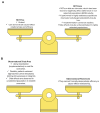Dos and Don'ts in Kidney Nutrition: Practical Considerations of a Panel of Experts on Protein Restriction and Plant-Based Diets for Patients Living with Chronic Kidney Disease
- PMID: 40573113
- PMCID: PMC12195896
- DOI: 10.3390/nu17122002
Dos and Don'ts in Kidney Nutrition: Practical Considerations of a Panel of Experts on Protein Restriction and Plant-Based Diets for Patients Living with Chronic Kidney Disease
Abstract
Dietary management is a pillar of chronic kidney disease (CKD) treatment. While some rules are the same as dietary prescriptions for the general population and those suffering from other chronic diseases (energy intake, salt intake, avoidance of ultra-processed food and limited intake of animal fats), in non-dialysis-dependent patients living with CKD, the specific focus is on protein intake. Low-protein diets (LPDs) and supplemented very low protein diets (sVLPDs) have been successfully employed to decrease the symptoms of people living with non-dialysis-dependent CKD, delay the progression of the disease and retard the need for dialysis. Randomized clinical trials have yielded conflicting results on efficacy, resulting in conflicting guidelines. Concerns about the risk of malnutrition (specifically when the main source of proteins is plant-derived), electrolyte imbalances, and energy intake, and the idea that adherence is difficult, jeopardize the use and wide application of LPDs and sVLPDs. That dietary management focuses mainly on nutrients while dietary quality occupies second place is also an erroneous concept that requires discussion. In September 2023, a group of experts composed of nephrologists and dieticians gathered in Frankfurt, Germany, to try to reconcile the different guideline indications and address most of the common doubts of final dispatchers to increase the prescription of "renal diets" and improve people living with CKD's adherence to them.
Keywords: education; elderly patients; ketoanalogues; low-protein diets; protein intake; ultra-processed food.
Conflict of interest statement
The meeting on which the current paper is based was funded by Fresenius Kabi; authors received hospitality and transportation expenses and a consultancy fee. Fresenius Kabi had no role in the discussion or in the writing and editing of this manuscript.
Figures







Similar articles
-
Protein restriction for diabetic kidney disease.Cochrane Database Syst Rev. 2023 Jan 3;1(1):CD014906. doi: 10.1002/14651858.CD014906.pub2. Cochrane Database Syst Rev. 2023. PMID: 36594428 Free PMC article.
-
Dietary interventions for adults with chronic kidney disease.Cochrane Database Syst Rev. 2017 Apr 23;4(4):CD011998. doi: 10.1002/14651858.CD011998.pub2. Cochrane Database Syst Rev. 2017. PMID: 28434208 Free PMC article.
-
Replacing salt with low-sodium salt substitutes (LSSS) for cardiovascular health in adults, children and pregnant women.Cochrane Database Syst Rev. 2022 Aug 10;8(8):CD015207. doi: 10.1002/14651858.CD015207. Cochrane Database Syst Rev. 2022. PMID: 35944931 Free PMC article.
-
Early referral strategies for management of people with markers of renal disease: a systematic review of the evidence of clinical effectiveness, cost-effectiveness and economic analysis.Health Technol Assess. 2010 Apr;14(21):1-184. doi: 10.3310/hta14210. Health Technol Assess. 2010. PMID: 20441712
-
Design considerations for future renoprotection trials in the era of multiple therapies for chronic kidney disease.Nephrol Dial Transplant. 2025 Feb 5;40(Supplement_1):i70-i79. doi: 10.1093/ndt/gfae210. Nephrol Dial Transplant. 2025. PMID: 39907541 Free PMC article.
References
-
- Ikizler T.A., Burrowes J.D., Byham-Gray L.D., Campbell K.L., Carrero J.J., Chan W., Fouque D., Friedman A.N., Ghaddar S., Goldstein-Fuchs D.J., et al. KDOQI Clinical Practice Guideline for Nutrition in CKD: 2020 Update. Am. J. Kidney Dis. 2020;76:S1–S107. doi: 10.1053/j.ajkd.2020.05.006. - DOI - PubMed
-
- Stevens P.E., Ahmed S.B., Carrero J.J., Foster B., Francis A., Hall R.K., Herrington W.G., Hill G., Inker L.A., Kazancıoğlu R., et al. KDIGO 2024 Clinical Practice Guideline for the Evaluation and Management of Chronic Kidney Disease. Kidney Int. 2024;105:S117–S314. doi: 10.1016/j.kint.2023.10.018. - DOI - PubMed
-
- Piccoli G.B., Di Iorio B.R., Chatrenet A., D’Alessandro C., Nazha M., Capizzi I., Vigotti F.N., Fois A., Maxia S., Saulnier P., et al. Dietary satisfaction and quality of life in chronic kidney disease patients on low-protein diets: A multicentre study with long-term outcome data (TOrino-Pisa study) Nephrol. Dial. Transplant. 2020;35:790–802. doi: 10.1093/ndt/gfz147. - DOI - PubMed
Publication types
MeSH terms
Substances
LinkOut - more resources
Full Text Sources
Medical

